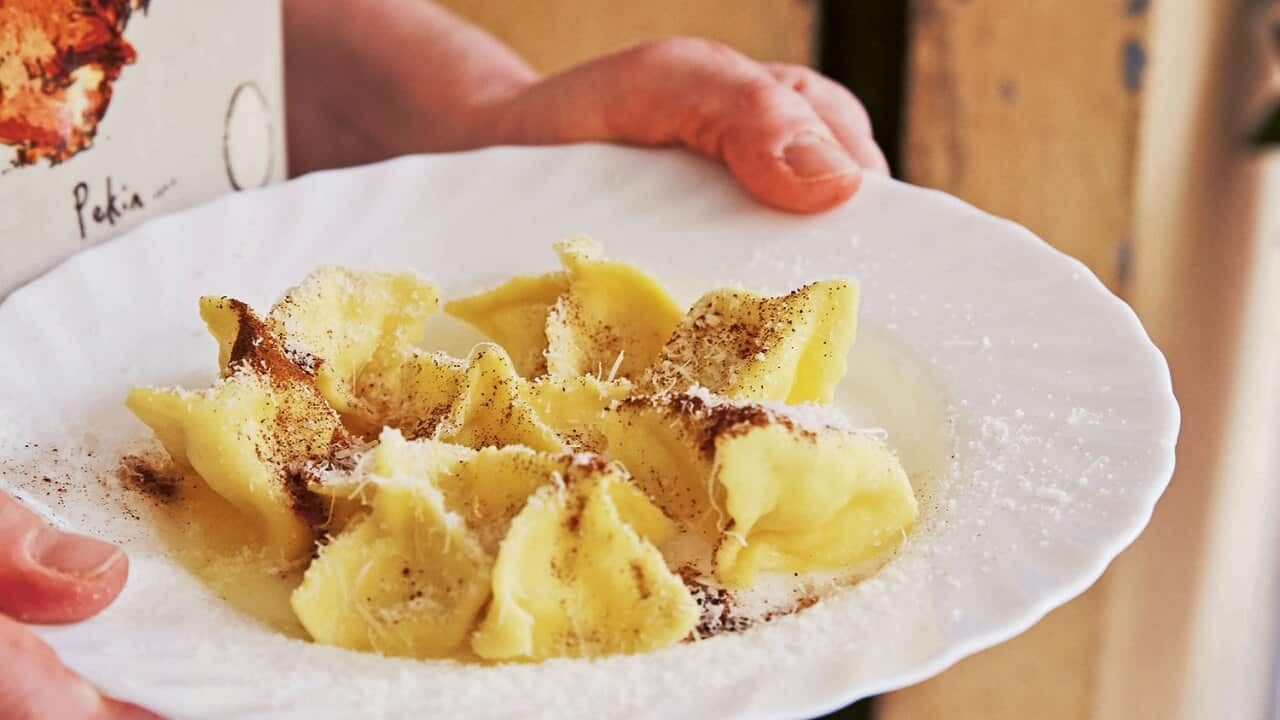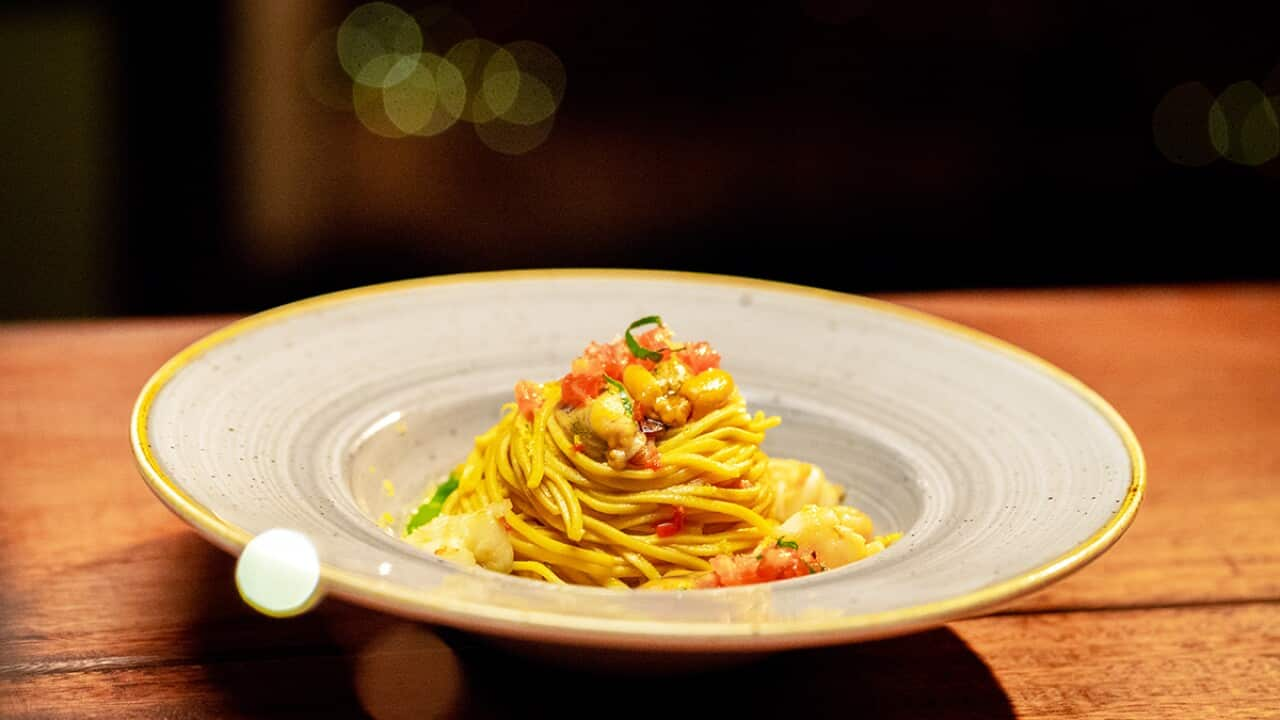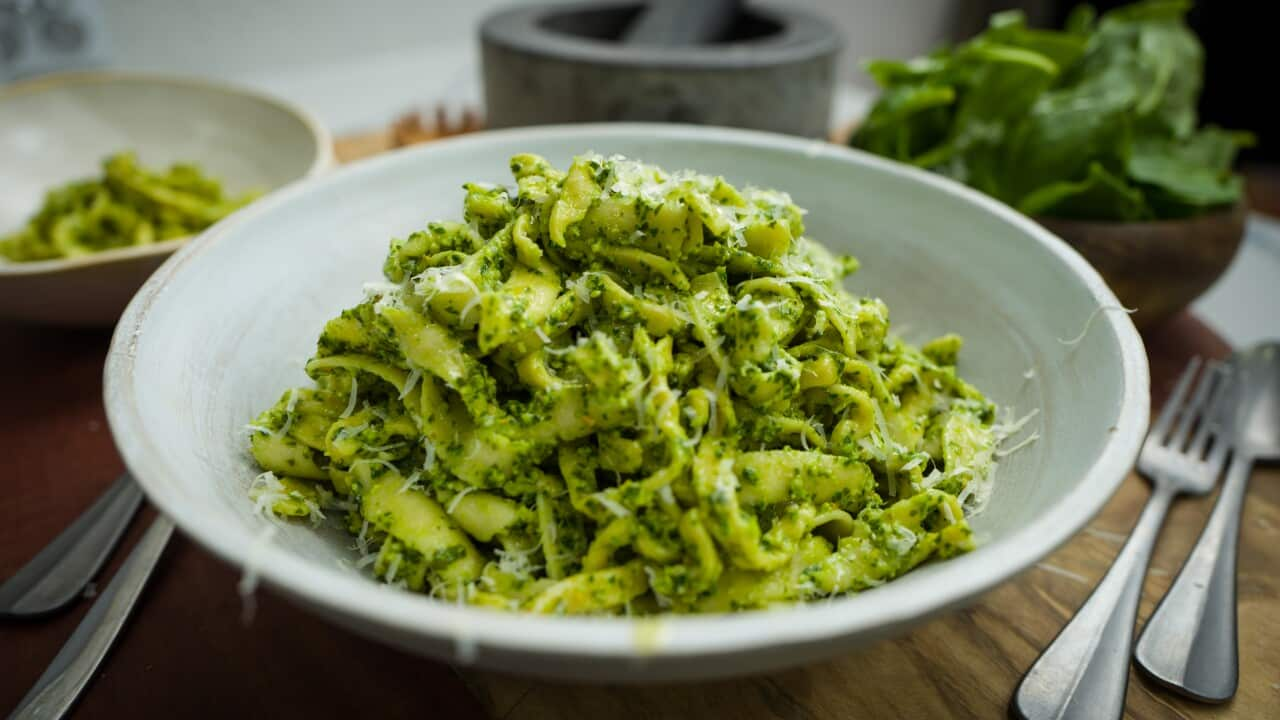Pasta is surely one of the universal crowd-pleasers. It's comforting, satisfying and delicious. It's also very simple to make... or is it?
Cooking pasta from scratch feels daunting because, much like , no one can seem to agree on a recipe. It feels like a lot of hard work when opening a packet is surely just as good?
No, opening a packet of pasta is not just as good. Especially if you're making . Or . Or .
Ask the experts
We figured the best way to up our pasta prowess was to gather tips from those who make pasta for a living.
- The author of bestselling cookbooks and new book , Julia also teaches sell-out Melbourne pasta masterclasses. - Silvia is the host of SBS Food's and a passionate food writer and home cook who learned to cook pasta as a child in the kitchens of her mother and grandmother.
- Silvia is the host of SBS Food's and a passionate food writer and home cook who learned to cook pasta as a child in the kitchens of her mother and grandmother.

Julia Busuttil Nishimura is a cook, author and pasta master. Source: Supplied
Maria Mandile and Maflada Guerrera - These two Australian nonnas have been best friends for more than fifty years. They've also been making pasta for family and friends for over seventy. That's almost a century and a half of pasta cooking between them.
It's not that hard
"Pasta is the easiest food to make," Mafalda firmly tells SBS Food. "It's really not that hard."
Not unless it's an Australian brand of packet pasta. According to Maria, "That stuff is hard as a rock. It needs at least double the cooking time, maybe more."
"Making fresh pasta isn't an overly complicated thing." - Julia Busuttil Nishimura.
But we're getting ahead of ourselves. Generally, when we talk about pasta being 'hard', we're talking about making it from scratch. This is a daunting prospect for many, but it doesn't need to be. Recipe .
Recipe .

Please that crowd! Source: Alan Benson
"Making fresh pasta isn't an overly complicated thing," says Julia. "After all, it is simply semolina flour, water and salt or flour, eggs and salt.
It does, however, require a little practice to get it right, and of course some time. Because of this, it is often put in the ‘too hard’ basket.
Julia is adamant that once people have a go at making fresh pasta, they will find it a pleasurable experience.
The basic ingredients
You'd be hard-pressed to find a definitive 'recipe' for making fresh pasta. Every region of Italy has its own particular mix, and every home cook and chef has adapted the one they grew up with.
The basic ingredients are usually the same - flour, eggs, salt - but the ratio differs tremendously. uses four eggs, a mix of whole eggs and egg yolks, Silvia often .
It's true that you can easily make pasta with just flour, water and salt. Adding eggs will help the dough bind and provide extra nourishment, but it's not essential. Says Maria, who grew up in the Benevento region of Campania (where her friend Mafalda also hails from), "plain, fresh pasta with no egg takes no time to make and even less time to cook. If you put egg in your dough, it takes more time to knead, more time to cook. It makes more flavour, but it also takes more time."
Says Maria, who grew up in the Benevento region of Campania (where her friend Mafalda also hails from), "plain, fresh pasta with no egg takes no time to make and even less time to cook. If you put egg in your dough, it takes more time to knead, more time to cook. It makes more flavour, but it also takes more time."

It all comes together to make one of the world's great comfort foods. Source: Hardie Grant Books / Andrew Montgomery
Mafalda agrees that a plain dough is your best bet when you're in a rush (or simply don't have any eggs). She believes that when you factor in cooking time, preparing, kneading and rolling out a fresh egg-less dough is just as quick as opening up a packet of pasta.
All about the flour
Eggs might be optional when making pasta, but flour is obviously essential. The best flour to use for making your dough is a mix of semolina and 00 flours.
Fine 00 (double zero) specialty flour - which is also sold as "tipo 00" flour (or type 00) - is finely-milled Italian wheat flour that is slightly softer than regular plain flour. It creates a silkier, chewier pasta. You can substitute plain flour for 00 and your recipe would work just fine. You would be unlikely to notice a difference in texture, and Mafalda is happy to note that she often makes her pasta with regular flour and semolina if she doesn't have 00 flour to hand, or just entirely with semolina flour.
Semolina is made from durum wheat and is a courser flour than regular plain flour. It's much higher in gluten than regular flour (around 13% gluten compared with 8-11% gluten in regular), so it helps pasta keep its shape during cooking. Pasta shapes are often made with semolina flour alone, whereas long-strand pasta like spaghetti, pappardelle or lasagne often use a mix of 00 and semolina.
About those shapes
The array of pasta shapes available can mean that making fresh pasta feel more daunting than it actually is. It helps to know that apart from the whole 'will I or won't I add egg to my dough' thing, the variances in pasta are all about the shapes. The dough recipe stays the same.
Aside from the novelty of a new shape to tempt the eye, different sauces suit different shapes.
As a general rule, Julia says that egg doughs are suited to be rolled out with a pasta machine and semolina and water doughs are usually for hand-rolled shapes like orecchiette, cavatelli and gnochetti.
Aside from the novelty of a new shape to tempt the eye, different sauces suit different shapes. The more liquid the sauce, the better suited to coat long pasta shapes like spaghetti or linguine. Heartier sauces suit wider ribbon pasta like pappardelle and mafaldine, and more delicate cream sauces are best with thinner strands like fettuccine or tagliatelle. When it comes to hand-rolled pasta shapes like shells, twists and tubes, think about whether the pasta will 'cup' or 'cling' to the sauce. So shells shapes like conchiglie and lumache can 'cup' a heavy cream or meat sauce, whereas twists like fusilli or caserecce are better at allowing lighter sauces to 'cling'. Tubes like penne, rigatoni and macaroni are good cuppers, little shapes like orzo, fregola and stelline are clingers.
When it comes to hand-rolled pasta shapes like shells, twists and tubes, think about whether the pasta will 'cup' or 'cling' to the sauce. So shells shapes like conchiglie and lumache can 'cup' a heavy cream or meat sauce, whereas twists like fusilli or caserecce are better at allowing lighter sauces to 'cling'. Tubes like penne, rigatoni and macaroni are good cuppers, little shapes like orzo, fregola and stelline are clingers.

Rolling and shaping pasta with friends makes the time go extra quickly. Source: Getty Images
When it comes to hand-rolled pasta shapes like shells, twists and tubes, think about whether the pasta will 'cup' or 'cling' to the sauce.
Small tools that you can buy at Italian delis and specialty shops can make rolling pasta shapes much quicker, but you can make simple shapes using just your hands. Incidentally, you to make long strands of pasta, either. Rolling the dough out as thin as you can, then cutting by hand works just as well.
Getting the dough right
Once you've decided on your ingredients and shape, it's time to mix and prepare your dough.
Silvia recommends a basic ratio of one egg per 100 grams of 00 flour. "This ratio never fails," . "This is what my nonna taught me." Do keep in mind that plenty of variables will affect your dry (flour) to liquid (eggs or water) ratio on the day. Room temperature, flour type, size of eggs... this is why it's best to go by feel, not stick exactly to the recipe ratios.
Do keep in mind that plenty of variables will affect your dry (flour) to liquid (eggs or water) ratio on the day. Room temperature, flour type, size of eggs... this is why it's best to go by feel, not stick exactly to the recipe ratios.

Silvia prepares a fresh pasta dough on Cook Like an Italian. Source: Cook Like an Italian
Mix your flour, eggs and salt (or flour and water) with a spoon to begin with until it starts to come together, then bring it together with your hands. According to Silvia, your hands contribute heat to turn the flour and eggs into a solid dough, ready for kneading. The dough will be quite firm at this stage.
It's best to go by feel, not stick exactly to the recipe ratios.
"A few important things to remember is to not make your dough too wet," agrees Julia. "It should be the consistency of rather firm play dough and will require a good amount of vigorous kneading to get there - around 10 minutes."
Needy kneading
Kneading techniques vary almost as much as pasta recipes. The main thing to remember is that the purpose of kneading is to warm and stretch the gluten in the flour to create a soft, pliable dough. A good pummeling generally does the trick, but bear in mind that giving the dough a long resting time should negate the need to knead at all.
"Make sure your dough is well wrapped or covered with an upturned bowl to ensure it doesn't dry out," says Julia. "Rest the dough at room temperature for at least 30 minutes or up to four hours. This ensures the gluten is well-rested, making the rolling process much easier." This is probably why Mafalda pulls her pasta dough together in the morning and leaves it to rest for a full day before rolling it out ready for dinner. Maria also grew up making tomorrow's dough the night before. The dough rests overnight, then in the morning Maria rolls it out and leaves the strands or shapes to sit during the day. This dries out the dough, helping it better hold its shape during cooking.
This is probably why Mafalda pulls her pasta dough together in the morning and leaves it to rest for a full day before rolling it out ready for dinner. Maria also grew up making tomorrow's dough the night before. The dough rests overnight, then in the morning Maria rolls it out and leaves the strands or shapes to sit during the day. This dries out the dough, helping it better hold its shape during cooking.

Kneading the dough will help stretch the gluten in the flour, resulting in silky pasta. Source: Getty Images
Mafalda pulls her pasta dough together in the morning and leaves it to rest for a full day before rolling it out ready for dinner.
Finally, the cook
All of our experts agree that pasta needs plenty of room to cook. Use the biggest pot you can find. Generally, it's recommended that every 100 grams of pasta needs two litres of water. Add salt to taste, but roughly one teaspoon of salt per litre is common. This may seem much saltier than you're used to, so experiment and find what ratio suits you best.
It's good to add your salt to the water after you bring it to boil. Definitely bring the water to boil before you add the pasta.
"I’ve seen people put the pasta in cold water straight onto the stove to bring it to the boil," says Mafalda, aghast. "Don’t do that! Boil the water first.”
Maria advises adding a little oil to the water to help stop the pasta from sticking. Mafalda is quick to disagree with her old friend. "You don’t put it in a pot and walk away - that's when you might need the oil," she says. "Instead of adding your good oil, you stay close and stir it every now and then."
To the tooth, friends
Pasta is cooked with its al dente, or "to the tooth". This means it still has a little bite to it, it's not completely soft. Fresh pasta will take just minutes to reach al dente, depending on the shape. Long, thin strands can take only moments. The best way to know if the pasta is ready is to pull a piece out and bite into it. It should be tender, but firm to the bite. Recipe .
Recipe .

Silvia's hand rolled and cut tagliatelle with ragú Napoletano. Source: Cook like an Italian
Once it's ready, drain your pasta in a large colander. Julia advises holding back a little of the pasta water. "It is salty and starchy and can be added in small amounts to the pasta and sauce cooking in the pan," she says.
Both Maria and Mafalda prefer to finish cooking the pasta in the sauce they're serving it with. This helps the flavour of the dish better infuse into the strands or shapes of the pasta.
"Once you’ve cooked your pasta to al dente, put it into your pan and cook for a bit until the remaining water dries up and you can hear it start to fry," says Maria. "Then you add your sauce and finish the cooking.”
A word on that sauce
When it comes to a pasta sauce, the nonnas both agree that a plain, meatless is the best sauce to serve with fresh pasta. Not too heavy, not too light, but just right. The trick to getting as much flavour into this simple dish is a low and slow cooking time. ", onions, basil, celery, carrot - anything you've got to hand can go into your sauce, chopped up nice and fine," says Maria. "The more you put in there, the more flavour you've got. Then you simmer it really low for hours until it's rich and thick. Two hours, three, even four if you're around. It softly cooks away while you get on with your day. The little pop of bubbles is a nice music, don't you think?"
", onions, basil, celery, carrot - anything you've got to hand can go into your sauce, chopped up nice and fine," says Maria. "The more you put in there, the more flavour you've got. Then you simmer it really low for hours until it's rich and thick. Two hours, three, even four if you're around. It softly cooks away while you get on with your day. The little pop of bubbles is a nice music, don't you think?"

A rich homemade tomato passata is all you really need to make fresh pasta sing. Source: Petrina Tinslay
Freshly does it

Franca’s classic lasagna with bolognese









